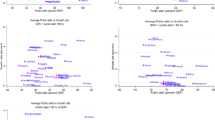Abstract
Large external imbalances and fragile fiscal positions have emerged as major policy challenges for the euro area in the financial crisis. The paper analyses whether shifting government purchases between tradable and non-tradable goods could help reduce external fluctuations without large swings in the overall fiscal stance. The policy rules considered are budgetary-neutral in the sense that the overall level of government expenditure is kept constant. We compare the policy rules to fiscal devaluation as a strategy to reduce external imbalances and find that state-dependent changes in the composition of government purchases between tradables and non-tradables can stabilise excessive fluctuations in the event of economy-wide supply and demand shocks. Contrary to fiscal devaluation, the expenditure-shifting rule faces a trade-off between stabilising domestic activity and enhancing household welfare, on the one hand, and reducing excessive fluctuations in external positions, on the other hand. The excess volatility of domestic variables associated less volatility in the external position implies welfare losses for standard specifications of household utility. The adverse welfare effect is absent in the case of fiscal devaluation.





Similar content being viewed by others
Notes
Rabanal and Tuesta (2013) show that the distinction between tradable and non-tradable goods is important to understand real exchange rate fluctuations and that non-tradable technology shocks explain about one third of real exchange rate volatility.
Kumhof and Laxton (2013b) use inflation adjustment instead of price adjustment costs in their discussion of simple fiscal policy rules for open economies. Contrary to the standard price adjustment costs implying purely forward-looking inflation dynamics, inflation adjustment costs are a mechanism to generate endogenous inflation persistence.
The EU’s internal market and public procurement policies have weakened the case for the alternative assumption of strong/full home bias in government consumption.
The emphasis on simple instrument rules owes to their practical advantages over fully optimal policy solutions. Contrary to the fully optimal policy solution, simple rules use a limited set of information. Compliance with simple rules is, consequently, easier to monitor than the commitment to fully optimal policy, and the feasibility of compliance monitoring mitigates the credibility/time-consistency problem. Credibility is crucial, because it determines the policy maker’s ability to anchor the expectations of households and firms.
The countries are AUT, BEL, ESP, FIN, GRC, IRL, NLD and PRT. The focus on this group of smaller countries among the early EA members is motivated by the fact that these countries have already more than one decade of EA history to quantify the role of asymmetric shocks.
To keep the analysis concise, we only show the results for output gap stabilisation. Results for a policy rule reacting to the employment gap are similar to the results for the policy rule responding to the output gap.
More detailed impulse responses, including separate IRFs for the frictionless economy, can be found in the related working paper (Hohberger et al. 2013).
Here, we combine the different policy instruments (Table 3) in one Figure.
The different illustrated parameter ranges in Fig. 4 are chosen to assume that both policies responds to a 0.5 percentage-point decline in the trade balance gap by a tax (expenditure) shift from labour to consumption tax (T to NT goods) of approximately 1 percentage point (1 percentage point of GDP).
References
Abiad A, Bluedorn J, Guajardo J, Kumhof M, Leigh D (2011) Separated at birth? The twin budget and trade balances. In: International Monetary Fund (ed) World Economic Outlook: Slowing Growth, Rising Risks, September 2011, Washington DC, pp 135–160
Adao B, Correia I, Teles P (2010) Wage and price flexibility in a monetary union. Open Econ Rev 21(1):109–126
Ali Abbas SM, Bouhga-Hagbe B, Fatás A, Mauro P, Velloso RC (2011) Fiscal policy and the current account. IMF Econ Rev 59:603–629
Aspachs-Bracons O, Rabanal P (2010) The drivers of housing cycles in Spain. SERIEs 1:101–130
Beetsma R, Jensen H (2004) Mark-up fluctuations and fiscal policy stabilization in a monetary union. J Macroecon 26:357–376
Christopoulou R, Vermeulen P (2012) Markups in the euro area and the US over the period 1981–2004: a comparison of 50 sectors. Empir Econ 42(1):53–77
Correia IH (2011) Fiscal devaluation. In: Banco de Portugal (ed) Economic Bulletin, Winter 2011, Volume 17(4), Lisboa, pp 27–39
Corsetti G, Müller G (2006) Budget deficits and current accounts: openness and fiscal persistence. Econ Policy 21:597–638
De Mooij R, Keen M (2013) “Fiscal devaluation” and fiscal consolidation: the VAT in troubled times. In: Alesina A, Giavazzi F (eds) Fiscal policy after the financial crisis. University of Chicago Press, Chicago, pp 443–485
Dellas H, Tavlas GS (2005) Wage rigidity and monetary union. Econ J 115(506):907–927
Druant M, Fabiani S, Kezdi G, Lamo A, Martins F, Sabbatici R (2009) How are firms’ wages and prices linked: survey evidence in Europe. Working Paper Series 1084, European Central Bank
Duval R, Vogel L (2012) How do nominal and real rigidities interact? A tale of the second best. J Money Credit Bank 44(7):1455–1474
ECB (2012) Competitiveness and external imbalances within the Euro Area. Occasional Paper Series 139, European Central Bank
Engler P, Fidora M, Thimann C (2009) External imbalances and the US current account: how supply-side changes affect an exchange rate adjustment. Rev Int Econ 17:927–941
Engler P, Ganelli G, Tervala J, Voigts S (2013) Fiscal devaluation in a monetary union. Free University Berlin, School of Business and Economics, Discussion Paper 2013/18
Erceg CJ, Henderson DW, Levin AT (2000) Optimal monetary policy with staggered wage and price contracts. J Monet Econ 46(2):281–313
Evers M (2012) Federal fiscal transfer rules in monetary unions. Eur Econ Rev 56:507–525
Evers M, de Mooij R, van Vuuren D (2008) The wage elasticity of labour supply: a synthesis of empirical estimates. De Econ 156:25–43
Farhi E, Gopinath G, Itskhoki O (2011) Fiscal devaluations. NBER Working Paper 17662
Ferrero A (2009) Fiscal and monetary rules for a currency union. J Int Econ 77:1–10
Fiorito R, Zanella G (2008) Labor supply elasticities: can micro be misleading for macro? Working Paper 4, Department of the Treasury, Ministry of the Economy and of Finance
Forni L, Monteforte L, Sessa L (2009) The general equilibrium effects of fiscal policy: estimates for the euro area. J Public Econ 93:559–585
Furceri D, Zdzienicka A (2012) Financial integration and fiscal policy. Open Econ Rev 25(5):805–822
Galí J, Monacelli T (2008) Optimal monetary and fiscal policy in a currency union. J Int Econ 76:116–132
Galí J, López-Salido D, Vallés J (2007) Understanding the effects of government spending on consumption. J Eur Econ Assoc 5(1):227–270
Herz B, Hohberger S (2013) Fiscal policy, monetary regimes and current account dynamics. Rev Int Econ 21(1):118–136
Hohberger S, Vogel L, Herz B (2013) Budgetary-neutral fiscal policy rules and external adjustment. Wirtschaftswissenschaftliche Diskussionspapiere der Universität Bayreuth 04–13
Imbs J, Méjean I (2010) Trade elasticities: a final report for the European Commission. European Economy Economic Paper 432, European Commission
Kim S, Roubini N (2008) Twin deficits or twin divergence? Fiscal policy, current account and real exchange rate in the U.S. J Int Econ 74:362–383
Kirsanova T, Satchi M, Vines D, Wren-Lewis S (2007) Optimal fiscal policy rules in a monetary union. J Money Credit Bank 39:1759–1784
Knell M (2013) Nominal and real wage rigidities. In theory and in Europe. J Macroecon 36(C):89–105
Kollmann R (1996) Incomplete asset markets and the cross-country consumption correlation puzzle. J Econ Dyn Control 20:945–961
Kumhof M, Laxton D (2013a) Fiscal deficits and current account deficits. J Econ Dyn Control 37(10):2062–2082
Kumhof M, Laxton D (2013b) Simple fiscal policy rules for small open economies. J Int Econ 91:113–127
Lane PR (2010) Some lessons for fiscal policy from the financial crisis. In: Holden S, Andersen TM (ed) Nordic economic policy review: fiscal consequences of the crisis. Number 1/2010, Copenhagen, pp 13–34
Lombardo G, Ravenna F (2012) The size of the tradable and non-tradable sectors: evidence from input–output tables for 25 countries. Econ Lett 116(3):558–561
Lubik T, Schorfheide F (2006) A Bayesian look at new open economy macroeconomics. In: Gertler M, Rogoff K (ed) NBER Macroeconomics Annual 2005, Volume 20, National Bureau of Economic Research, pp 313–382
Obstfeld M, Rogoff K (2005) Global current account imbalances and exchange rate adjustments. Brook Pap Econ Act 36(1):67–146
Obstfeld M, Rogoff K (2007) The unsustainable U.S. Current account position revisited. In: Clarida R (ed) G7 Current account imbalances: sustainability and adjustment. National Bureau of Economic Research Conference Report, pp 339–376
Rabanal P (2009) Inflation differentials between Spain and the EMU: a DSGE perspective. J Money Credit Bank 41:1141–1166
Rabanal P, Tuesta V (2013) Nontradable goods and the real exchange rate. Open Econ Rev 24(3):495–535
Ratto M, Roeger W, in’t Veld J (2009) QUEST III: an estimated open-economy DSGE model of the euro area with fiscal and monetary policy. Econ Model 26:222–233
Schmitt-Grohé S, Uribe M (2003) Closing small open economy models. J Int Econ 61:163–185
Vogel L, Roeger W, Herz B (2013) The performance of simple fiscal policy rules in monetary union. Open Econ Rev 24(1):165–196
Acknowledgments
The authors would like to thank in particular the editor-in-chief George S. Tavlas, an anonymous referee, Francesco Marchionne, and Marika Cioffi for very helpful comments as well as participants of the International Conference on ‘The Financing and the Adjustment Sharing of External Imbalances’ (Ancona), the Annual International Conference on Macroeconomic Analysis and International Finance (Rethymno), the Annual European Economics and Finance Society Conference (Berlin), the Annual Congress of the European Economic Association (Gothenburg), and the annual meeting of the German Economic Association (Düsseldorf) for helpful suggestions.
Disclosure
The views in this paper are personal and should not be attributed to the European Commission.
Author information
Authors and Affiliations
Corresponding author
Rights and permissions
About this article
Cite this article
Hohberger, S., Vogel, L. & Herz, B. Budgetary-Neutral Fiscal Policy Rules and External Adjustment. Open Econ Rev 25, 909–936 (2014). https://doi.org/10.1007/s11079-014-9314-z
Published:
Issue Date:
DOI: https://doi.org/10.1007/s11079-014-9314-z




